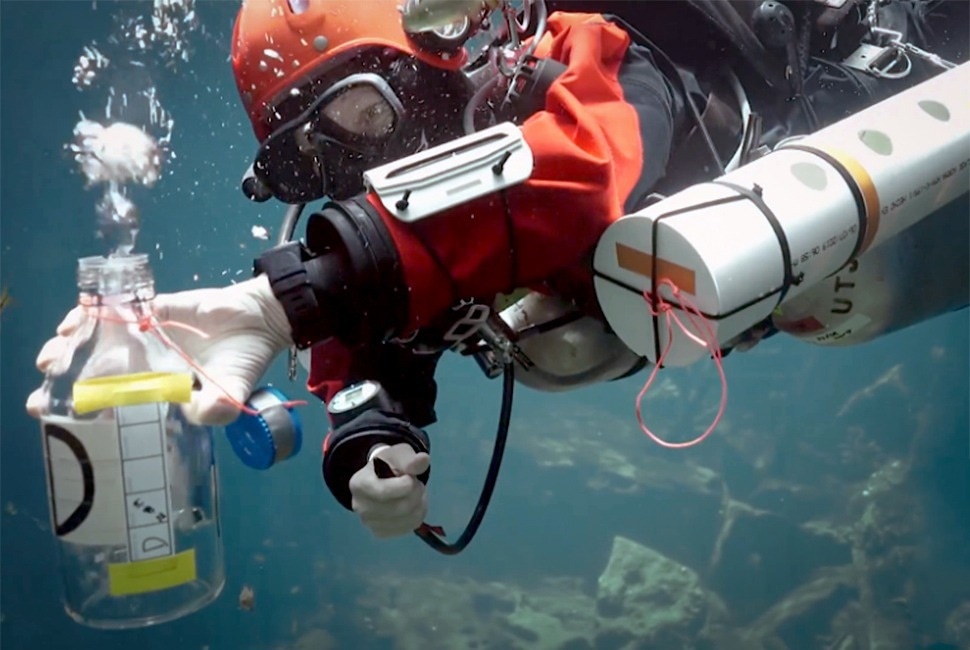Assisted by an adept underwater cave-diving team, scientists from Northwestern University have meticulously charted the most comprehensive map to date of microbial communities inhabiting the submerged mazes beneath Mexico’s Yucatán Peninsula.
 A diver in the Yucatan aquifer uses an air hose to empty and then flood a 1-liter bottle with a water sample. Image Credit: Natalie Gibb.
A diver in the Yucatan aquifer uses an air hose to empty and then flood a 1-liter bottle with a water sample. Image Credit: Natalie Gibb.
While previous investigations focused on collecting samples from cave entrances and easily accessible sinkholes, the Northwestern-led team delved into the deep, lightless passages of the underwater labyrinth to gain deeper insights into the survival dynamics of this distinctive subterranean environment.
Upon scrutinizing the gathered samples, the researchers identified a remarkably diverse system with well-defined patterns of organization. Resembling the social dynamics of a typical high school lunchroom, microbial communities within the cave system exhibited a tendency to form distinct cliques.
Interestingly, one particular family of bacteria, Comamonadaceae, emerged as a sociable standout, making appearances at nearly two-thirds of the metaphorical "cafeteria tables." These findings suggest that Comamonadaceae plays a crucial role as the ecological linchpin in the broader community.
This is certainly the most expansive microbial survey across this part of the world. These are incredibly special samples of underground rivers that are particularly difficult to obtain. From those samples, we were able to sequence the genes from microbial populations that live in these sites. This underground river system provides drinking water for millions of people. So, whatever happens with the microbial communities there has the potential to be felt by humans.”
Magdalena R. Osburn, Study Lead, Northwestern University
Specializing in geobiology, Osburn holds the position of Associate Professor in the Department of Earth and Planetary Sciences at Northwestern's Weinberg College of Arts and Sciences.
The leadership of this project was undertaken by Northwestern alumnus Matthew Selensky during his doctoral research in Osburn's laboratory. Patricia Beddows, a Professor of Earth and Planetary Sciences at Weinberg, and a co-author of the study, spearheaded the cave-diving expedition, drawing on her extensive decades-long experience in researching these caves.
Among the other contributors from Northwestern are Andrew Jacobson, a Professor of Earth and Planetary Sciences, and Former Graduate Student Karyn DeFranco, who specialized in geochemistry.
The vast Yucatán carbonate aquifer, primarily situated in southeastern Mexico, is characterized by numerous sinkholes that lead to an intricate network of underwater caves.
This system, which houses a diverse yet insufficiently studied microbiome, features areas with freshwater, seawater, and combinations of both. The network encompasses various zones, ranging from pitch-black, deep pits without direct openings to the surface to shallower sinkholes illuminated by sunlight.
The Yucatan platform is essentially a Swiss cheese of cave conduits. We were curious which microbes are found together when we look across the whole system versus which microbes are found within one ‘neighborhood.’”
Magdalena R. Osburn, Study Lead, Northwestern University
In pursuit of answers, a team of cave divers meticulously gathered 78 water samples from 12 distinct sites within the cave system adjacent to the Caribbean coast in Quintana Roo, Mexico.
This comprehensive sampling effort extended from the northern Xunaan Ha system to inland and coastal regions of the Sac Actun system, which notably included a distinct 60-meter-deep pit, and further south to the Ox Bel Ha system.
Upon returning to a dive-shop-transformed science laboratory, researchers extracted cells from each sample and conducted a thorough chemical analysis. Subsequently, back at Northwestern University, they employed DNA sequencing to identify microbial communities in the samples.
To further analyze the data set, Selensky developed an innovative computational program for network analysis. The resulting networks unveiled the species that exhibited a tendency to coexist.
In evaluating each site, the researchers took into account the environmental context of each microbial community, considering factors such as cave type (pit or conduit), cave system, distance from the Caribbean coast, geochemistry, and position in the water column.
Despite the inflow of water from the Gulf of Mexico into the Yucatán aquifer, the researchers observed substantial variations in the aquifer’s microbiome compared to the nearby sea. Additionally, the microbiomes displayed significant diversity within the cave system, differing from cave to cave and from shallow water to deep water.
The microbial communities form distinct niches. There is a varying cast of characters that seem to move around, depending on where you look. But when you look across the whole data set, there’s a core set of organisms that seem to be performing key roles in each ecosystem.”
Magdalena R. Osburn, Study Lead, Northwestern University
Osburn and her research team observed that Comamonadaceae, a bacterial family commonly associated with groundwater systems, thrived in various niches.
Furthermore, their investigation revealed that the highest concentration of microbial communities was found in a deep, pit-like sinkhole with a surface opening, permitting sunlight to permeate. These communities were organized into layers of distinct niches across the water column.
Osburn stated, “It seems that Comamonadaceae performs slightly different roles in different parts of the aquifer, but it’s always performing a major role. Depending on the region, it has a different partner. Comamonadaceae and its partners probably have some mutualistic metabolism, maybe sharing food.”
Source:
Journal reference:
Osburn, M. R., et al. (2023) Microbial biogeography of the eastern Yucatán carbonate aquifer. Applied and Environmental Microbiology. doi.org/10.1128/aem.01682-23.